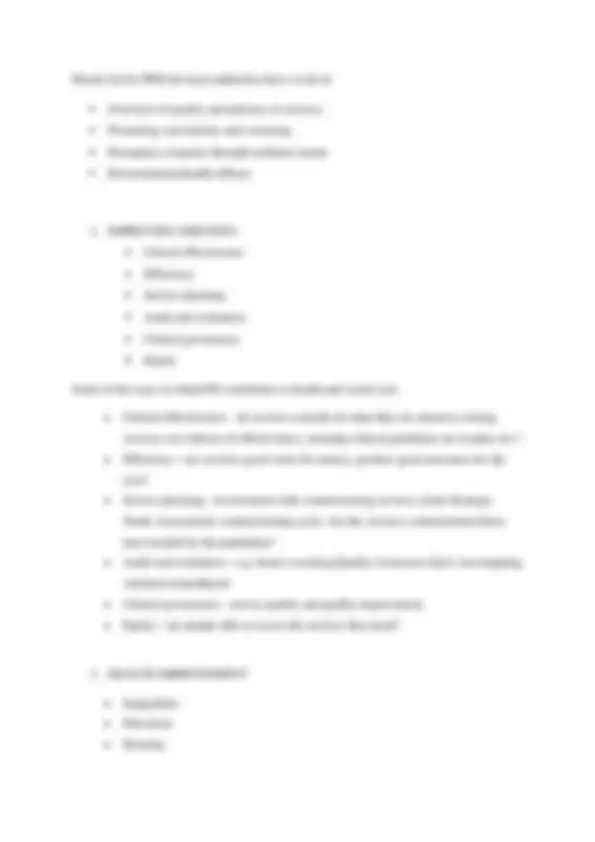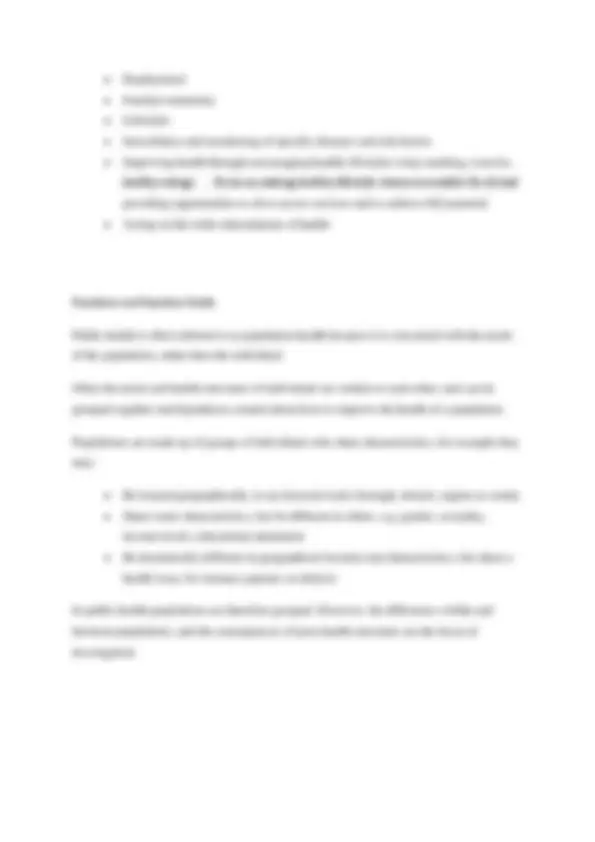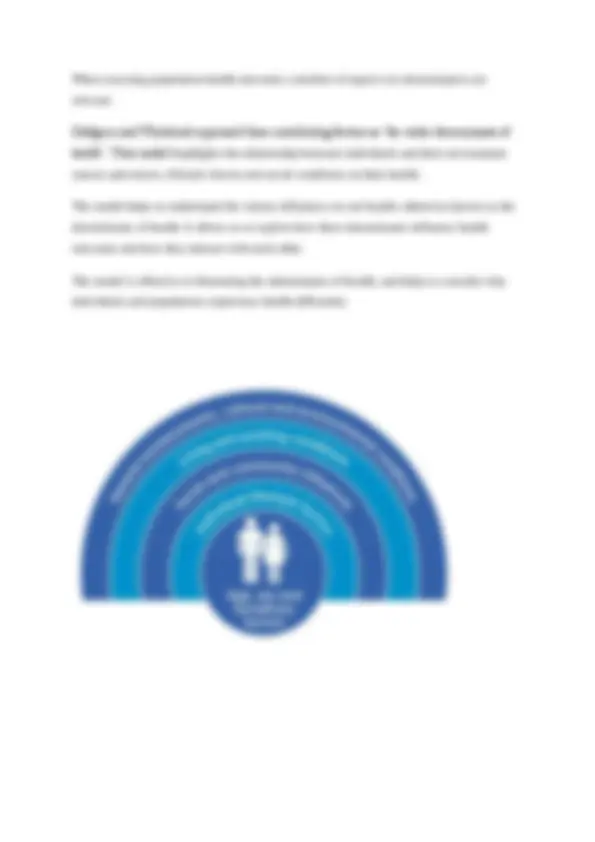







Study with the several resources on Docsity

Earn points by helping other students or get them with a premium plan


Prepare for your exams
Study with the several resources on Docsity

Earn points to download
Earn points by helping other students or get them with a premium plan
Community
Ask the community for help and clear up your study doubts
Discover the best universities in your country according to Docsity users
Free resources
Download our free guides on studying techniques, anxiety management strategies, and thesis advice from Docsity tutors
Detailed notes about public health intelligence.
Typology: Study notes
1 / 9

This page cannot be seen from the preview
Don't miss anything!






What do you understand about health? LIFESTYLE: lifestyle behaviours, such as physical activity, diet or risky behaviours can have a positive and negative effect on our health. Some have immediate and obvious effects, eg the release of hormones after a workout, whilst others can have detrimental long-term impacts which wont be experienced for some time, ie smoking or a sedentary lifestyle. MENTAL HEALTH: mental health does not refer only to severe mental illness, but also includes how we perceive our own wellbeing, how we feel about ourselves and how we engage within society. COMMUNITY : community plays a large part in health as it can impact on an individuals wellbeing. Social isolation, such as not engaging within your community, is a significant influence on health. Positive engagement, regardless of health-status can impact on our health. DISEASE: disease, whether communicable (passed on person to person), or non- communicable (caused by genetics, environment or lifestyle) is a major factor in health. However it can still be possible to feel healthy and active even with long term conditions, or conversely to be well yet feel unhealthy. AGE: good health is not something which we could expect to lose as we age. Throughout the life course, perception of our health can change significantly. However as we grow older we become more vulnerable to certain types of condition. TREATMENT: general practice and hospital settings are important for nurturing sick people back to health, but healthcare isn’t restricted to those settings. Social care provides vital practical and emotional support for children and adults who have additional needs to enable them to lead healthy lives. Voluntary sector organisations and charities play a vital role in providing this support.
Public health refers to all organised measures (whether public or private) to prevent disease, promote health, and prolong life among the population as a whole (WHO 2015) Public health is about helping people to stay healthy, and protecting them from threats to their health. The government wants everyone to be able to make healthier choices, regardless of their circumstances, and to minimise the risk and impact of illness (Public Health England 2018) Public health is concerned with improving the health of the population rather than treating the diseases of individual patients (Donaldson 2003) The science and art of promoting and protecting health and well-being, preventing ill- health and prolonging life through the organised efforts of society (Acheson 1988) These definitions identify a number of key concepts: Health of the population rather than induviduals Improving health and prevention rather than treating disease Whilst there is a scientific approach to reducing disease the challenge is to communicate this to the population so they can benefit Organised society highlights how one organisation cannot tackle public health alone, that society and its components need to come together to improve health. CORE FUNCTIONS OF PUBLIC HEALTH
Employment Family/community Lifestyles Surveillance and monitoring of specific diseases and risk factors Improving health through encouraging healthy lifestyles (stop smoking, exercise, healthy eating) …. focus on making healthy lifestyle choices accessible for all and providing opportunities to all to access services and to achieve full potential Acting on the wider determinants of health Populations and Population Health Public health is often referred to as population health because it is concerned with the needs of the population, rather than the individual. Often the needs and health outcomes of individuals are similar to each other, and can be grouped together and hypotheses created about how to improve the health of a population. Populations are made up of groups of individuals who share characteristics, for example they may: Be located geographically; in an electoral ward, borough, district, region or county Share some characteristics, but be different in others, e.g. gender, sexuality, income levels, educational attainment Be dramatically different in geographical location and characteristics, but share a health issue, for instance patients on dialysis In public health populations are therefore grouped. However, the differences within and between populations, and the consequences of poor health outcomes are the focus of investigation.
When assessing population health outcomes a number of aspects (or determinants) are relevant. Dahlgren and Whitehead expressed these contributing factors as ’the wider determinants of health’. Their model highlights the relationship between individuals and their environment (macro and micro), lifestyle factors and social conditions on their health. The model helps us understand the various influences on our health, otherwise known as the determinants of health. It allows us to explore how these determinants influence health outcomes and how they interact with each other. The model is effective in illustrating the determinants of health, and helps to consider why individuals and populations experience health differently.
This was the earliest example of epidemiology – taking a population approach to studying the patterns and movement of disease. First Public Health Act In 1848 this was the first Public Health Act in the world and shifted responsibility of the poor from the local parishes to the Poor Law Commission. In the same year the first Medical Officer of Health (the equivalent of today’s Director of Public Health) was appointed in Liverpool. Florence Nightingale and the birth of data visualisation After returning from the Crimean war where she famously served as a nurse, Florence Nightingale pioneered the development of data visualisation and statistics to highlight the issues of health in the British Army. Florence Nightingale realised that the visualisation of statistics was a more powerful way to influence change than simply campaigning. Her report ’Mortality of the British Army 1858’ highlighted the issues of treating wounded men and the volume of deaths occurring as a result of infection. Her graphical representation of this, the Coxcomb, is still used today. Milk in Schools Scheme Following the introduction of free school meals in 1921 so that children could take full advantage of the education offered to them, the government introduced free milk to schools in 1934. Whilst this was initially a temporary measure to increase the overall health of children, milk continued to be provided to secondary school children until 1968, to children aged over seven until 1971, and to over fives until 1980.
Inequalities in Health: The Black Report 1980 This government commissioned report highlighted that inequalities; differences in health outcomes between rich and poor within England, were not down to variation in the NHS, but rather a complex interwoven set of social issues creating social inequalities influencing health, income, education, housing, diet and employment. The report recommended a wide ranging strategy of social policy measures to combat inequalities. However the report was difficult to obtain due to the then government restricting the number of copies printed, and as a result few of the measures or ideas were implemented. The Health and Social Care Act 2012 This Act was the biggest reorganisation of the NHS, commissioning and Public Health since the inception of the NHS in 1948. It came into force on 1st April 2013. The Act abolished Primary Care Trusts (PCTs) and Strategic Health Authorities, and transferred most of the NHS commissioning budget to the newly formed Clinical Commissioning Groups (CCGs). Locally, the Public Health function was transferred to Local Authorities from PCTs where they assumed statutory responsibility for a number of key Public Health programmes. Both NHS England and Public Health England (an executive agency of the Department of Health and Social Care) were established. Smoking Ban A smoking ban in England, making it illegal to smoke in all enclosed work places and many public shared spaces. It came into force on 1st July 2007. Health inequalities are the preventable, unfair and unjust differences in health status between groups, populations or individuals that arise from the unequal distribution of social, environment and economic conditions within societies, which determine the risk of people